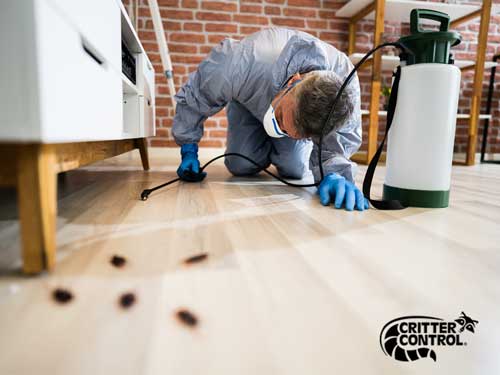Reliable A1 Bed Bug Treatment in Charlotte - Safe and Proven Methods
Reliable A1 Bed Bug Treatment in Charlotte - Safe and Proven Methods
Blog Article
Bed Pest Therapy Break Down: Contrasting Chemical Vs. Non-Chemical Solutions
In the world of insect control, specifically when dealing with the consistent concern of bed pests, the option in between chemical and non-chemical therapy solutions can be a crucial one. Both techniques provide unique benefits and downsides, affecting elements such as efficiency, security factors to consider, and total expense. By examining the nuanced details of each approach, a clearer understanding of which path to go after in resolving a bed pest infestation can be acquired.
Effectiveness of Chemical Treatments
Chemical treatments for bed insect invasions have actually been extensively identified for their potent and fast efficacy in eliminating these insects. When thinking about the performance of chemical therapies, it is essential to understand that they can provide a complete and quick option to a bed insect issue. Professional pest control experts usually rely on pesticides to target bed pests at numerous phases of their life cycle, consisting of adults, eggs, and nymphs. These chemicals generally work by disrupting the bed insects' nerve system, causing paralysis and eventual death.
Furthermore, chemical treatments have the advantage of providing residual effects, suggesting that they can remain to remove bed insects also after the initial application. This recurring activity is particularly valuable in combating any prospective re-infestations. Additionally, the quick action of chemical therapies can bring alleviation to individuals encountering extreme bed pest invasions, allowing them to reclaim control of their living areas promptly.
Safety And Security Worry About Chemical Solutions
One critical facet that needs careful factor to consider when making use of chemical services for bed insect therapy is making certain the security of occupants and the environment. Direct exposure to specific chemicals utilized in bed insect treatments can lead to breathing problems, skin inflammation, or various other adverse reactions, specifically in individuals with pre-existing conditions or level of sensitivities.
Additionally, the ecological influence of chemical remedies is one more considerable consideration. Some chemicals utilized in bed bug therapies may be dangerous to valuable pests, wildlife, and ecosystems if they leach right into the soil or water supply. It is crucial to use chemical treatments judiciously, following safety standards, and taking into consideration less toxic alternatives to reduce these risks and guarantee the effective and risk-free administration of bed pest invasions.
Advantages of Non-Chemical Methods
Considering the potential security concerns and environmental impact linked with chemical solutions for bed pest therapy, exploring non-chemical strategies presents an encouraging choice with several distinct advantages. Non-chemical therapies are eco friendly, as they do not add to air or water pollution, making them a lasting choice for pest control.
In addition, non-chemical solutions can be reliable in targeting bed bugs, consisting of hard-to-reach locations where chemical therapies may not penetrate - A1 bed bug treatment in charlotte. Approaches such as warmth therapy, vacuuming, steam cleaning, and mattress encasements provide extensive elimination without the use of hazardous chemicals.
Limitations of Non-Chemical Treatments

Additionally, non-chemical therapies often require multiple applications to attain effective obliteration. This can be taxing and might not constantly assure total removal of all bed insects and click here to find out more their eggs, particularly in hard-to-reach or surprise places.
Furthermore, the success of non-chemical therapies heavily relies upon correct execution and thoroughness, which can be testing for individuals without expert proficiency. Insufficient application of non-chemical approaches may lead to insufficient eradication, bring about consistent invasions and the demand for extra treatments.
Consequently, while non-chemical treatments have their benefits, it is vital to recognize these limitations and consider them when determining the most effective strategy for managing bed pest infestations.
Expense Comparison: Chemical Vs. Non-Chemical Options
Provided the constraints connected with non-chemical therapies, a necessary element to assess in the context of bed insect management is the price comparison between chemical and non-chemical alternatives. Chemical treatments normally entail the application of insecticides by specialists, which can vary from $250 to $900 per space, depending on the seriousness of the invasion and the size of the location to be treated. In comparison, non-chemical therapies like heat treatment or heavy steam can be a lot more costly, with prices ranging from $1,000 to $6,000 for an entire home. While the preliminary price of chemical treatments might appear lower, numerous therapies might be called for to completely eradicate the problem, possibly enhancing the general expense. On the various other hand, non-chemical alternatives may offer a more lasting and environmentally friendly remedy, although they can be cost-prohibitive for some individuals. Eventually, when thinking about the price of bed bug treatment choices, it is important to consider the ahead of time expenses against the effectiveness and lasting sustainability of the selected technique.
Final Thought

Considering the possible safety problems and environmental influence linked with chemical remedies for bed bug treatment, discovering non-chemical strategies provides an this link encouraging choice with a number of unique benefits.Offered the limitations connected with non-chemical treatments, a necessary element to examine in the context of bed bug administration is the cost contrast between chemical and non-chemical options. In comparison, non-chemical therapies like warmth treatment or heavy steam can be extra pricey, with costs ranging from $1,000 to $6,000 for an entire home. While the preliminary cost of chemical therapies might appear lower, multiple treatments might be called for to completely eradicate the infestation, potentially raising the general expense.In verdict, when contrasting chemical and non-chemical bed insect therapy choices, it is essential to think about efficiency, safety and security, benefits, limitations, and cost.
Report this page